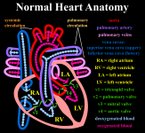Great vessels transposition
Transposition of the great vessels (TGV) is a group of congenital heart defects (CHDs) involving an abnormal spatial arrangement of any of the primary vessels: superior and/or inferior vena cavae (SVC, IVC), pulmonary artery, pulmonary veins, and aorta. more...
Description
In a normal heart, oxygen-depleted ("blue") blood is pumped from the right side of the heart, through the pulmonary artery, to the lungs where it is oxygenated. The oxygen-rich ("red") blood then returns to the left heart, via the pulmonary veins, and is pumped through the aorta to the rest of the body, including the heart muscle itself.
Transposed vessels can present a large variety of atriovenous, ventriculoarterial and/or arteriovenous discordance. The effects may range from a change in blood pressure to an interruption in circulation, depending on the nature and degree of the misplacement and which vessels are involved.
Terminology
The term "TGV" is often used as a more specific reference to transposition of the great arteries (TGA); however, TGA only relates to the aorta and the pulmonary artery, whereas TGV is a broader term which can relate to these vessels as well as the SVC, IVC, and pulmonary veins.
In it’s strictest sense, transposition of vessels relates only to defects in which two or more vessels have "swapped" positions; in a broader sense, it may be taken to relate to any defect in which a vessel is in an abnormal position.
Variations and similar defects
Simple and complex TGV
In many cases, TGV is accompanied by other heart defects, the most common type being intracardiac shunts such as atrial septal defect (ASD) including patent foramen ovale (PFO), ventricular septal defect (VSD), and patent ductus arteriosus (PDA). Stenosis, or other defects, of valves and/or vessels may also be present.
When no other heart defects are present it is called 'simple' TGV; when other defects are present it is called 'complex' TGV.
Similar defects
The following defects involve abnormal spatial and/or structural arrangement of the great vessels:
- Total anomalous pulmonary venous connection (TAPVC)
- Partial anomalous pulmonary Venous Connection (PAPVC)
- Coarctation of the aorta
- Cor triatriatum
- dextro-Transposition of the great arteries (d-TGA)
- Double outlet right ventricle (DORV)
- Hypoplastic left heart syndrome (HLHS)
- levo-Transposition of the great arteries (l-TGA)
- Overriding aorta
- Patent ductus arteriosus (PDA)
- Pulmonary atresia (PA)
- Unilateral or bilateral Pulmonary arteriovenous malformation (PAVM)
- Pulmonary sequestration
- Scimitar syndrome
- Sinus venosus atrial septal defect (SVASD)
- Situs inversus
- Tetralogy of Fallot (TOF)
- Truncus arteriosus (TA)
- Vascular rings
-
Read more at Wikipedia.org



